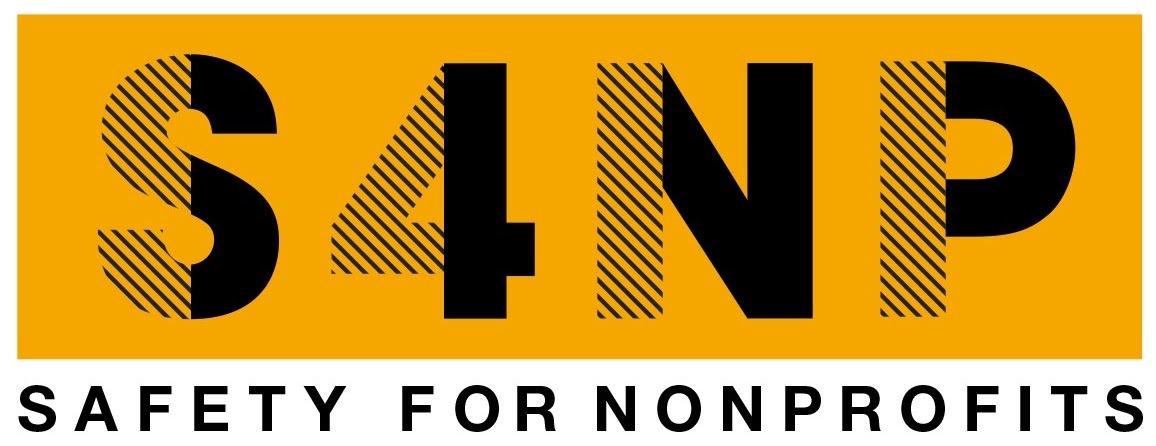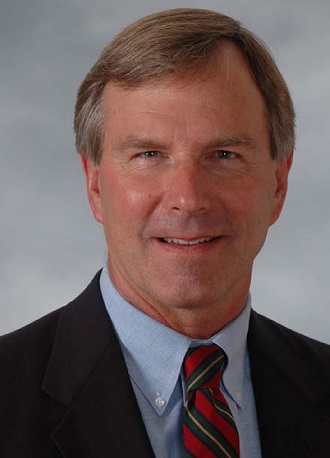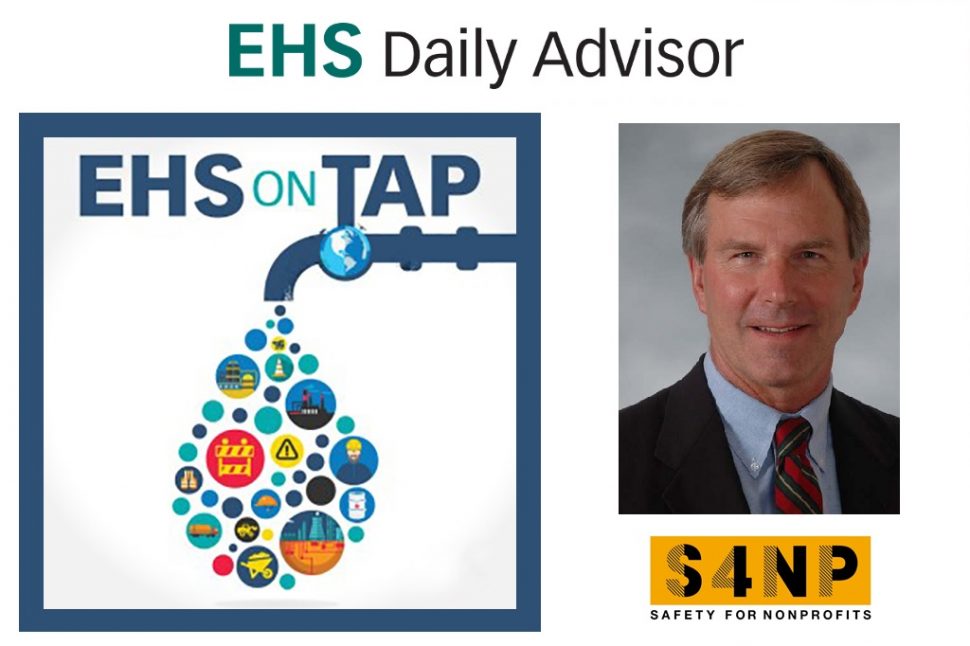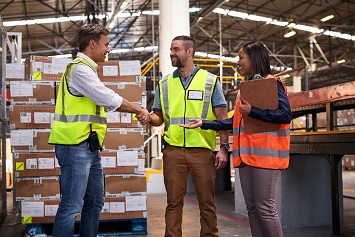Workplace safety and health conversations too often leave out a certain category of business: nonprofits. Yet nonprofit organizations, which are often heavily staffed by dedicated volunteers, share many of the same vulnerabilities as any other organization. For National Volunteer Week this week, the EHS on Tap podcast sat down with Jack Geissert, the founder and president of Safety for NonProfits (S4NP) for a chat about how he and S4NP provide a helping hand to nonprofits with pro bono health and safety services.
Justin Scace: Hello, everyone, and welcome to EHS on Tap. I’m your host, Justin Scace, Senior Editor of the EHS Daily Advisor. Now, when we talk about workplace safety and health, too often a certain category of business is left out of the conversation: nonprofits. Yet these organizations, often heavily staffed by dedicated volunteers, are just as vulnerable to hazards as any other for-profit organization. On today’s podcast, we’re sitting down with a veteran safety professional who is looking to close this gap, and we’ll discuss how he and his organization are looking to provide a helping hand to nonprofits with pro bono health and safety services.
Our guest on the show today is Jack Geissert, the founder and president of Safety for NonProfits, or S4NP for short. Jack has worked in the environment, health, and safety field for 45 years, including leadership roles in industries ranging from bio-pharmaceuticals to semiconductor and computer manufacturing to environmental remediation. An emeritus professional member of the American Society of Safety Professional’s (ASSP) Greater Boston Chapter, Jack is also the coauthor of the upcoming book Don’t Forget the Worker: Stories of Workplace Safety and Health. So, Jack, welcome, and thank you for joining us on EHS on Tap.
Jack Geissert: Justin, thanks for having me here today.
Justin Scace: It’s great to have you. So, to start things off, I mentioned a few things in our intro, but could you tell us a little bit about yourself and your career in safety?
Jack Geissert: Yeah, Justin, I’m happy to talk about myself, but I think most of the audience is really interested in hearing about S4NP. But I’ll just say that in more than 45 years of professional health, safety, and environmental work, throughout my entire career, I’ve been an unabashed advocate for workplace safety and health and worker health and safety. To me, that’s something that really carries through to the S4NP and our purpose and mission.
 Justin Scace: Absolutely. Now, as you mentioned, you’re here today to discuss Safety for NonProfits, or S4NP, an organization of which you are the founder and president. So how did S4NP get its start? And what is the mission of your organization?
Justin Scace: Absolutely. Now, as you mentioned, you’re here today to discuss Safety for NonProfits, or S4NP, an organization of which you are the founder and president. So how did S4NP get its start? And what is the mission of your organization?
Jack Geissert: Well, let me just start with the mission and goal of S4NP. It’s to encourage and enable our fellow professionals to deliver pro bono advisory services to nonprofits in their local communities. That’s really the vision. If I had to create a vivid image of what we are trying to accomplish, it’s that we’re trying to increase the outreach and the give back of the professionals. And how we started, we’ve created from scratch this new nonprofit organization whose purpose it is to remove the barriers that our fellow occupational health and safety professionals have that would keep them from delivering services and helping in their communities. And one of the key concerns or barriers is professional liability. I mean, I’ll spare you the details now for you and the audience. We can go into more detail about the governance and how we’re structured—that’s not so important. Really what I’d like to do now is just talk a little bit about the why of it.
Why are we considering forming this organization on a national basis to address, specifically, workplace safety and health nonprofits? And just as far as background, I’m just looking at a sheet of some facts here. And when it comes to nonprofit organizations, it’s an underappreciated part of our society, and our fabric and our safety net, in our society in the United States. There are 1.3 million 501(c)(3) organizations in the United States. So, when we talk about 501(c)(3) organizations, that’s the Internal Revenue Service (IRS_ designation for nonprofits, where the donors are able to deduct their donations and funds that they send to the nonprofit as a tax deduction. And so there are 1.3 million of these organizations, and in these organizations, one of the common aspects of them, if there is any commonality, is that they have filed as a public charity, and they have incorporated in their local state, their territory, or tribal governments as a public charity.
And as a result of that—just to let people know what really a nonprofit is about—they have quite a bit of visibility in terms of public access to information about how the organization is used, how the money is spent, etc. But as I’m saying, it’s a large part of our society. If you’ve helped out with your local Boy Scout and Girl Scout troops, perhaps on a Habitat for Humanity build, maybe you’ve helped out with the United Way, perhaps now you’re helping with some of the COVID response, maybe at a food pantry—these are examples. These are all run by nonprofit organizations. And when we look at the size and diversity, they make up 10% of the private sector employment and 5.3% of the gross domestic product. These are facts, but it also illustrates just the size of these organizations.
And again, that one commonality is that they have this designation from the IRS. And so, nonprofits tend to also be small; they have very few financial and other resources; and they may have a mix of employees, contractors, and volunteers. Like you said, Justin, they are similar to some of the emerging occupational health and safety issues associated with gig work. Likewise, work in nonprofits, whether you’re an employee or you’re a volunteer, there are certain workplace protections that somehow are at the lowest level of maturity. And of course, it all depends on the types of operations that they’re running because not the hazard level, depending on whether you’re doing a build at a Habitat affiliate build location or whether you’re in a nice, well-ventilated and lit office setting or working from home, the risk is going to be different. That’s a little bit of background information on what the nonprofits are facing.
And just a little bit how I got involved. Shortly after my retirement about 4 years ago from paid work, I started to give back in the community that I had lived in for about 25 years. And I started volunteering for a furniture bank. And I come from a family that has a very strong tradition of community outreach and service. And so it was just a natural thing for me. I was done with my professional career, I thought, and so I went to work and help in the community. And at this furniture bank, I moved furniture, I drove trucks, and I couldn’t help but notice that they would benefit a lot from a focused attention to some of the workplace health and safety issues that, as professionals, we’re all familiar with. And so I expanded the scope of my volunteer work into being a safety and health advisor. And I know now, 2 years later, that they are better and safer for the work and the risk assessment and the end-to-end support that I’ve provided them. I continue to support them as an advisor pro bono.
And so as I was developing this relationship with this nonprofit, I started to talk to some of my fellow professionals and asked if they had any experiences or if they were helping with workplace safety and health on any of the work they were doing in their retirement. I was talking to some of my retired friends, and some of them were doing this work, and others wanted to but were reluctant because of the professional liability. And so we started to explore the feasibility of this, and we thought for sure that there would be something within our profession, similar to the attorneys’ organizations and the retired business executives and medical community that gives back and volunteers. And so we started to look around; we talked to various stakeholders at the national associations, and what we discovered is that there was no such system for this. And that’s really the earliest stages of how S4NP was conceptualized and launched. There was a group of volunteers, and it’s amazing for me to look back now several years and to see the journey that we’ve been on. And so that’s a bit of background. I hope that’s helpful.
Justin Scace: Yeah, absolutely. Thank you for that. Too often, nonprofits may get overlooked when it comes to safety, but it should be obvious that employees of these companies, including volunteers, have the potential to be injured or even killed by hazards the same as anywhere else. You’ve discussed the hazards you encountered as a volunteer at a furniture bank, and I worked in a volunteer capacity after college at a therapeutic riding center, where there are large horses around. So, there are all sorts of very diverse hazards that could be in the nonprofit sector. But what are some of the specific hazards that you’ve seen in the nonprofit sector, and how does S4NP seek to help?
Jack Geissert: Yeah, I mean, good question, Justin. And it’s good to hear that you’ve done some volunteer work. I think that what we see and what we have found is that the hazards that are present of course depend on the type of operation and a lot of other variables. It depends on how much preplanning was put into the job, etc. But I mean, the most common hazards that we see in the nonprofits are the things that we see in general industry and in the private sector. Vehicular accidents are the leading cause of work accidents for all nonprofits across the board. In particular, volunteer emergency responders and disaster responders have a very high vehicular accident rate, including fatalities. Pedestrians, being struck by vehicles. We’ve had some tragic incidents in the past year at food pantries with volunteers being struck by vehicles and fatally injured. Working at heights, you start getting into construction and maintenance or other work. Musculoskeletal injuries, sadly also violence in the workplace, especially in the human services, where you’re trying to support the homeless community, and there are a lot of mental health issues.
And workplace violence is definitely an issue that all managers of nonprofits have to deal with. And the other thing is that indoor air quality can be an issue and also basic life safety and evacuation. There’s just a very wide variety, but ultimately, what it comes down to, if I were talking to a group of nonprofit leaders like we have, and really, the first recommendation we provide to them is to perform a risk assessment. And we can get into that later, but that really is fundamentally what we’re planning to do—through our volunteers, outreach into the communities, helping them understand the hazards, helping them prioritize them, and then helping them, on a priority basis, apply cost-effective solutions to reduce the risk to their employees and to their nonprofit and to their volunteers.
Justin Scace: Next I want to ask you, do you have any success stories from your organization, S4NP, that you’re particularly proud of, and could you tell us about them?
Jack Geissert: Yeah, we have had a number of successes. Now, I’ll just more broadly frame my response because I’ll frame it in the context of “have we had experience in general as an occupational health and safety community in delivering services to the nonprofit sector?” And the answer is yes. And so any time an occupational health and safety (OH&S) professional helps a nonprofit, that is when the state Occupational Safety and Health Administration (OSHA) consultation, the OSHA 21(d) consultation that’s available in every state, when they deliver services to a nonprofit, that is a success story because the nonprofit has requested it. When the nonprofit leadership asks for an insurance representative to come and perform a loss prevention survey, that is a success story. And most of our volunteers with S4NP have performed work in various capacities with nonprofits. One of our volunteers the other day helped the safety coordinator, a newly appointed safety coordinator, at a Habitat for Humanity affiliate fill out their OSHA 300 form, etc.
There’s a number of different ways that our community of OH&S professionals already, before S4NP got started, have been delivering these services. It’s just not at the level that is really needed. And the nonprofits in particular, especially with COVID, are struggling to stay afloat, run safe operations, and fulfill their mission. And the mission for nonprofits is everything; it defines what a nonprofit does. So that’s why we started talking about the mission of S4NP. And it’s to remove the barriers and to encourage our fellow OH&S professionals to get out there and deliver services. We’re in the process of putting in place insurance that will help us manage the professional liability, which is one of the main obstacles for why we as a community have not performed as much outreach.
Justin Scace: That’s great. Now, our audience for this podcast is made up of environment, health, and safety professionals. How can they help the mission of S4NP, and where could they learn more about it?
Jack Geissert: Yeah, Justin, thanks for asking. And one of the first things I’d say is that if one of our listeners, one of the audience, is already performing some volunteer work, helping with some health and safety at the local nonprofit, whether it’s the Girl Scouts or the soccer league or the animal rescue, keep doing it. The other thing we would ask is, please tell us about it because we know this is going on, and we’re trying to catalog some success stories, best practices, etc. There are other ways that you can help. We have our website, which is s4np.org, and are just setting up our donation button so that if there are people who wish to make a monetary donation, that’s always welcome. And if you would like to help us develop our program in particular, we’re currently conducting four proof-of-concept state capacity building projects. And that is, in four states, we’re developing the ability to do full on-site consultation to supplement what is already out there through state OSHA consultation through the insurance companies.
And those states are Arizona, Colorado, Ohio, and Massachusetts. So, if you would like to volunteer and help there, reach out to me. Go to our website, s4np.org, and it will get you into the system and will get you invited to help. We have some internal committees that are working behind the scenes to also build the back-office administrative capabilities. And so, if you are interested in helping design and build the business in what we call our phase two, that’s another volunteer opportunity. And I guess there’s one other area I wanted to mention, which is that if you’re a leader in either the ASSP chapter or the American Industrial Hygiene Association (AIHA) chapter, or some other affiliated organization—it could be the National Safety Council (NSC) chapter in your state or American Biological Safety Association (ABSA), etc., or the Applied Ergonomics Society (AES)—and want to get involved in this and partner with Safety for NonProfits, we’re all open to partnerships. So please reach out to me; my contact information is on the website.
Justin Scace: Well, this has been a great conversation and an important one to draw attention to this workplace safety issue and how EHS professionals can help. Thank you so much again, Jack, for taking the time to be with us today on EHS on Tap.
Jack Geissert: You’re very welcome.
Justin Scace: All right, now we’d also like to thank our audience for tuning in today, and remember to keep an eye out for new episodes of EHS on Tap, and keep reading the EHS Daily Advisor to stay on top of your safety and environmental compliance obligations, get the latest in best practices, and keep your finger on the pulse of all things related to the EHS industry. Until next time, this is Justin Scace for EHS on Tap.
 Jack Geissert, MPH, CIH, is founder and president of S4NP. With more than 40 years of paid professional occupational health and safety work, Geissert has turned his focus to helping nonprofit organizations with worker health and safety through S4NP. The S4NP team passionately believes that “People volunteering shouldn’t get hurt.” Learn more at www.s4np.org. Jack Geissert, MPH, CIH, is founder and president of S4NP. With more than 40 years of paid professional occupational health and safety work, Geissert has turned his focus to helping nonprofit organizations with worker health and safety through S4NP. The S4NP team passionately believes that “People volunteering shouldn’t get hurt.” Learn more at www.s4np.org. |
EHS on Tap is an environment, health, and safety podcast by BLR’s EHS Daily Advisor. On each episode of EHS on Tap, our host will discuss emerging legal, regulatory, and policy issues with industry experts and the impacts to everyday safety and environmental professionals. EHS on Tap topics run the gamut of contemporary issues facing EHS managers and professionals today.
Download the podcasts on iTunes here, and also be sure to visit our SoundCloud page for a full listing of all of our episodes!




